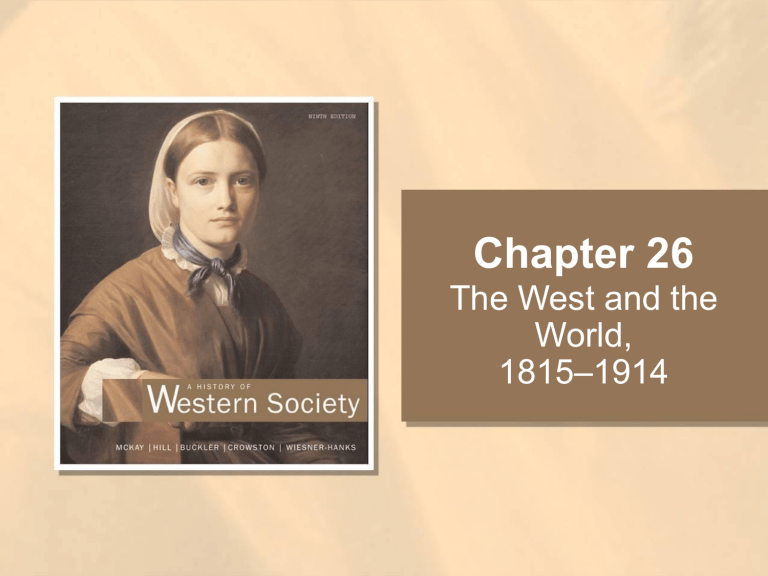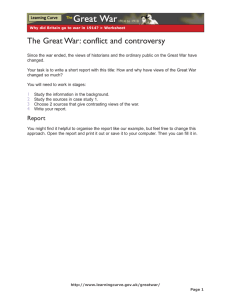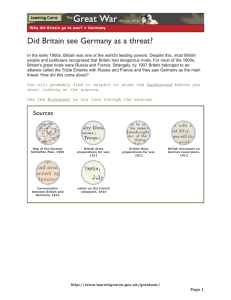
Chapter 26 The West and the World, 1815–1914 Africans in Madagascar transport a French diplomat in 1894, Africans in Madagascar transport a French diplomat in 1894, shortly before France annexed the island. Snark/Art Resource, NY The Growth of Average Income per Person in the Third World, Developed Countries, and Great Britain, 1750–1970 Growth is given in 1960 U.S. dollars and prices. P. Bairoch and M. Lévy-Leboyer, eds., Disparities in Economic Development Since the Industrial Revolution. Copyright © 1981. Reprinted by permission of Palgrave Macmillan, UK. British Ships and Shipbuilders The British continued to dominate international trade before the First World War. This handsome membership certificate of the British shipbuilders union features the vessels that drew the world together and were Britain’s pride. Britain’s thriving shipbuilding industry was concentrated in southern Scotland along the Clyde. Trade Union Congress, London/The Bridgeman Art Library European Investment to 1914 Foreign investment grew rapidly after 1850, and Britain, France, and Germany were the major investing nations. As this map suggests, most European investment was not directed to the African and Asian areas seized by the “new imperialism” after 1880. Britain and China at War, 1841 Britain capitalized on its overwhelming naval superiority, and this British aquatint celebrates a dramatic moment in a crucial battle near Guangzhou. Having received a direct hit from a steam-powered British ironclad, a Chinese sailing ship explodes into a wall of flame. The Chinese lost eleven ships and five hundred men in the twohour engagement; the British suffered only minor damage. National Maritime Museum, London The Increase of European and World Populations, 1750–1980 The Increase of European and World Populations, 1750–1980 W. Woodruff, Impact of Western Man: A Study of Europe’s Role in the World Economy. St. Martin’s Press, New York, 1967, p. 103; United Nations, Statistical Yearbook, 1982, 1985, pp. 2–3. Emigration from Europe by Decades, 1851–1940 Emigration from Europe by Decades, 1851–1940 Copyright © W. Woodruff, from Impact of Western Man, by W. Woodruff, 1982. Reprinted with permission of University Press of America. Origins and Destinations of European Emigrants, 1851–1960 Origins and Destinations of European Emigrants, 1851–1960 Copyright © W. Woodruff, from Impact of Western Man, by W. Woodruff, 1982. Reprinted with permission of University Press of America. An Italian Custom in Argentina Italian immigrants introduced the game of boccia to Argentina, where it took hold and became a popular recreation for men. Dressed up in their Sunday best, these Argentinian laborers are totally focused on the game, which is somewhat like horseshoes or shuffleboard. Hulton Archive/ Getty Images The Partition of Africa The European powers carved up Africa after 1880 and built vast political empires. European states also seized territory in Asia in the nineteenth century, although some Asian states and peoples managed to maintain their political independence, as may be seen on Map 26.3, page 864. The late nineteenth century was the high point of European imperialism. Compare the patterns of European imperialism in Africa and Asia, using this map and Map 26.3.•1 What European countries were leading imperialist states in both Africa and Asia, and what lands did they hold?•2 What countries in Africa and Asia maintained their political independence?•3 From an imperialist perspective, what in 1914 did the United States and Japan, two very different countries, have in common in Africa and Asia? Cecil Rhodes, Cecil Rhodes, after crushing the last African revolt in Rhodesia in 1896. Brown Brothers A Missionary School A Swahili schoolboy leads his classmates in a reading lesson in Dar es Salaam in German East Africa before 1914, as portraits of Emperor William II and his wife look down on the classroom. Europeans argued that they were spreading the benefits of a superior civilization with schools like this one, which is unusually solid because of its strategic location in the capital city. Ullstein Bilderdienst/The Granger Collection, New York Imperial Complexities in India Britain permitted many native princes to continue their rule, if they accepted British domination. This photo shows a road-building project designed to facilitate famine relief in a southern native state. Officials of the local Muslim prince and their British “advisers” watch over workers drawn from the Hindu majority. Nizam’s Good Works Project—Famine Relief: Road Building, Aurangabad 1895–1902, from Judith Mara Gutman, Through Indian Eyes. Courtesy, Private Collection The Rapid Modernization of the Japanese Army This woodcut from about 1870 shows Japanese soldiers outfitted in Western uniforms and marching in Western formation. Japanese reformers, impressed by Prussian discipline and success on the battlefield, looked to Germany for their military models. Ryogoku Tsuneo Tamba Collection/Laurie Platt Winfrey The Empress Dowager Tzu Hsi (1835–1908) Tzu Hsi drew on conservative forces, like the court eunuchs surrounding her here, to maintain her power. Three years after her death in 1908, a revolution broke out and forced the last Chinese emperor, a boy of six, to abdicate. Freer Gallery of Art and Arthur M. Sackler Gallery Archives, Smithsonian Institution. Photographer: Hsun-ling. Negative no. 261 An English lady attended by her Indian servants. An English lady attended by her Indian servants. Stapleton Collection, UK/The Bridgeman Art Library




